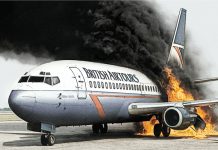When a vintage Junkers Ju 52/3m crashed in the Alps in August last year, Switzerland’s accident investigation body faced a difficult task. The 79-year-old aircraft was not equipped with flight recorders of any kind.
But on the first anniversary of the accident the Swiss Transportation Safety Investigation Board (STSB) has issued a status report on its progress investigating the crash that killed 20 people. It says data from mobile phones and digital cameras, and laser recreations of the doomed aircraft and the crash scene, may provide answers when the investigation is finalised next year.
The Ju 52/3m, operated as a sightseeing and nostalgia flight, took off from Locarno at 16:10 local time on August 4 last year with 17 passengers and three crew. Approximately 40 minutes later, the aeroplane flew on a north-north-easterly track into the valley south-west of the mountain Piz Segnas. Towards the northern end of the valley, the aeroplane began a left turn, which developed into a downward spiral-shaped trajectory. Seconds later the aeroplane collided almost vertically with the terrain and was destroyed.
The first on-site phase of the investigation included taking laser measurements of the wreckage and terrain. Other sources of information soon came to light.
‘It soon became apparent that several people had observed and filmed some of the accident or had photographed the aeroplane during the flight,’ the report says. ‘The fact that these eyewitnesses were at different locations made it possible to roughly reconstruct the flight path in the valley southwest of Piz Segnas for the first time.’
The report says it is now possible to reconstruct the entire history of the flight based on the various data storage devices. The valley south-west of Piz Segnas was captured using a three-dimensional laser scan and combined with the three-dimensional terrain model from the Swiss Federal Office of Topography. The STSB took a laser scan of another Junkers 52 and created a three-dimensional model of the aeroplane.
‘This means that images of the accident aircraft taken from the ground during the flight can now be positioned and analysed with regard to the terrain. This model can also be used to evaluate images from inside the aircraft to determine the flight path.’
Investigators recovered more than 40 mobile phones, digital cameras, memory cards and other components with possible data storage from the crash site.
‘The existing still images and video material should make it possible to determine the positions of the accident aircraft in space, its attitude relative to the terrain and its speed relative to the ground for the critical phase of the accident flight,’ the report says.
The STSB says spectral analysis of audio recordings from recording devices may make it possible to determine the revolutions per minute of the engines and draw conclusions about the condition of the engines during the course of the accident.
The STSB acknowledged the technical assistance of the French Bureau of Enquiry and Analysis (BEA) in recovering and interpreting electronic data. The report says ‘the safety investigation has already revealed important safety deficits which, although not directly related to the accident, should be mitigated with regard to the future operation of historic aircraft.’
The Junkers Ju 52/3m was developed as an airliner in the 1930s and used as a bomber in the Spanish Civil War and as a transport aircraft by Nazi Germany in World War II. It also served as an airliner after the war and as a utility aircraft in locations as diverse as northern Canada and Papua New Guinea.
Flight Safety Australia: back in print
- Flight Safety Australia is available now by subscription from the CASA Online Store for $39.95 for four issues a year, delivered to your door in Australia.
- Subscribe by 25 August to receive the Spring 2019 issue. Subscribers after that date will receive the Summer issue as their first.
- The first 900 subscribers get the gift of a kneeboard, a multitool or a fuel drain (their choice, stocks permitting) with their subscription.
- Subscribe at shop.casa.gov.au





Comments are closed.